Discover the mystical role of psalteries in biblical texts, unveiling a hidden layer of spiritual significance and cultural heritage.
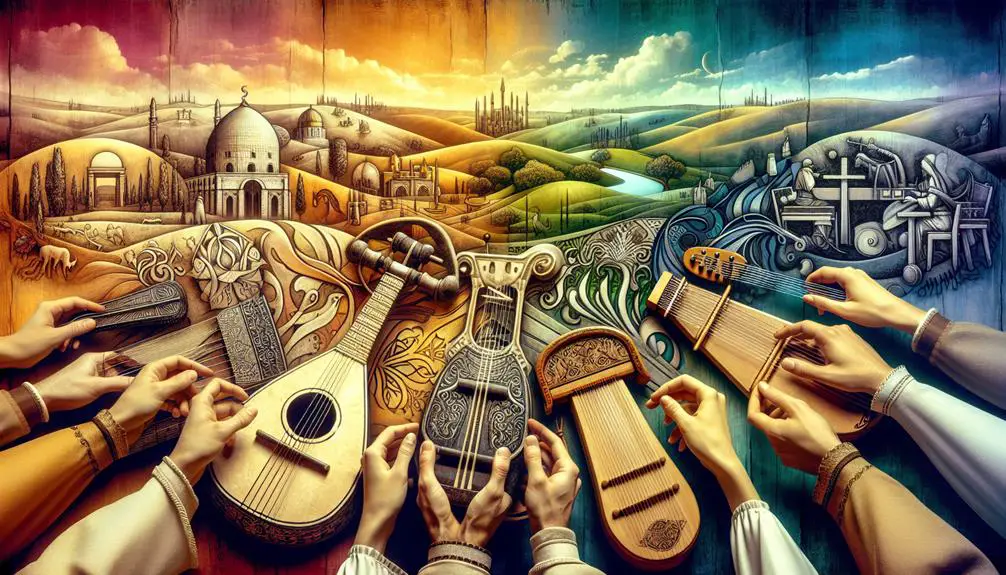
Psalteries in the Bible
You've likely heard theories about the significance of psalteries in biblical texts, but how much truth lies behind these claims?
The psaltery, an ancient stringed instrument, holds a unique place in biblical history, particularly within the Psalms, where its strings resonate with the spiritual fervor of the time. Its construction, symbolism, and the role it played in worship are not just historical footnotes but weave deeply into the fabric of religious and cultural identity.
As you uncover the layers of meaning behind the psaltery's presence in sacred texts, you'll find yourself on the cusp of a deeper understanding of its legacy and its profound impact on worship practices across cultures.
Key Takeaways
- Psalteries symbolize divine joy and spiritual warfare in biblical contexts.
- They were integral to both secular and sacred music traditions in biblical times.
- The Bible showcases psalteries' role in elevating prayers and praises to God.
- Psalteries' construction and design variations reflect their cultural and religious significance in the Bible.
Origins of the Psaltery
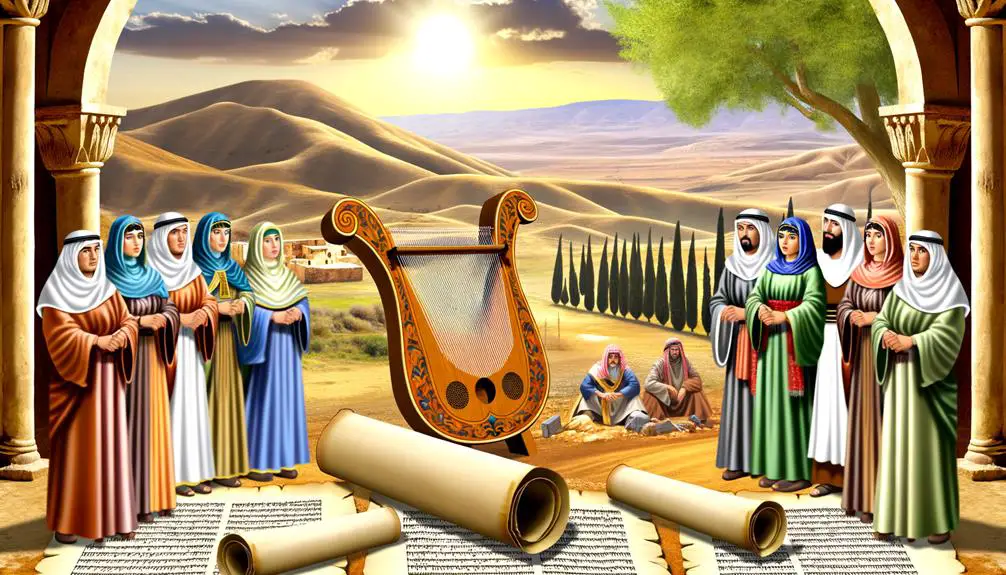
The psaltery, an ancient stringed instrument mentioned throughout biblical texts, traces its origins back to the early periods of the Middle Eastern civilizations, where it played a pivotal role in both secular and sacred music traditions. As you delve into the history of the psaltery, it's crucial to understand the diversity in playing techniques that have evolved over centuries. Typically, the instrument was played by plucking the strings with the fingers or with a plectrum, offering a range of tonal possibilities that were deeply intertwined with the cultural and emotional tapestry of the time.
Performance contexts for the psaltery varied widely, reflecting its versatility and the profound significance it held in society. In secular settings, the psaltery's melodious tones accompanied poetic recitations and storytelling, enhancing the narrative and immersing the audience in the experience. This instrument wasn't just a medium for entertainment; it was a crucial element in the communal sharing of stories and traditions, facilitating a deeper connection among individuals through the power of music.
In sacred contexts, the psaltery's role was equally significant. Its ethereal sounds were integral to religious ceremonies and worship, elevating the spiritual atmosphere and aiding in the expression of devotion and prayer. The playing techniques in these settings were often more subdued and contemplative, reflecting the solemnity of the occasion.
Understanding the origins of the psaltery, including its playing techniques and performance contexts, offers a window into the cultural and spiritual life of ancient Middle Eastern civilizations. The instrument's enduring presence in biblical texts underscores its significance and the rich heritage it represents.
Psalteries in Psalms
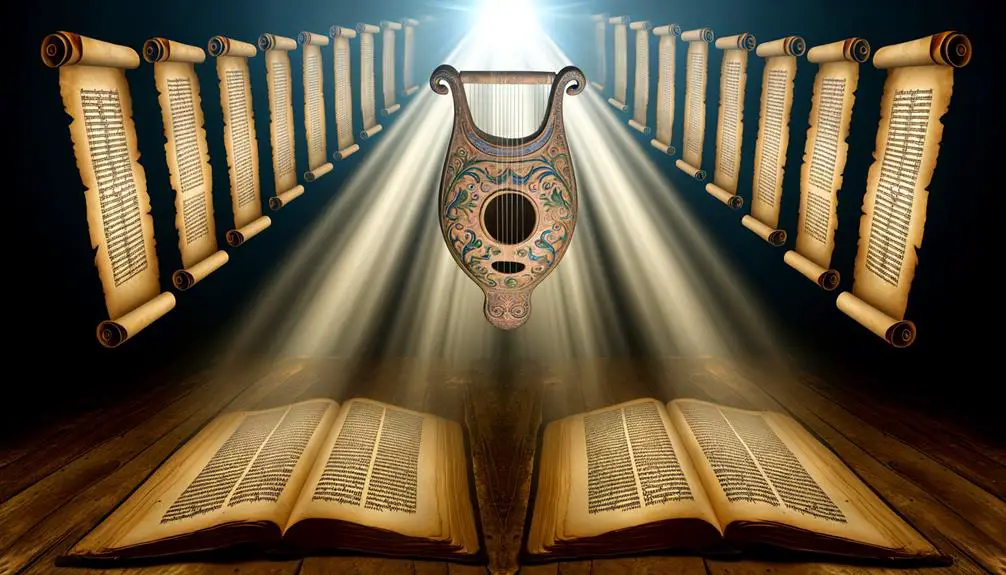
Delving into the Psalms, you'll find that psalteries play a pivotal role, not merely as musical instruments, but as profound symbols of worship and divine connection. This presence isn't incidental but deeply woven into the fabric of the text, reflecting the instrument's significant musical influence on the lyrical themes within this biblical book. The psaltery, a stringed instrument akin to a small harp, resonates through the Psalms as a conduit for spiritual expression, underscoring the emotive depth and breadth of human-divine interaction.
Analyzing the usage of psalteries in Psalms, it's evident that they aren't only instruments of praise but also of lamentation, celebration, and reflection. Their sound accompanies prayers for deliverance, songs of thanksgiving, and meditations on the divine law. This multifaceted role highlights the psaltery's capacity to embody the spectrum of human emotions and experiences, channeling them into a sacred discourse with the divine.
Furthermore, the integration of psalteries into these compositions illuminates the cultural and religious significance of music in ancient worship practices. It underscores how musicality and spirituality intertwine, with the psaltery acting as a bridge between the earthly and the divine. Through its strings, worshippers could elevate their prayers, thoughts, and emotions, weaving them into a divine tapestry of sound that transcends the mundane.
In essence, the presence of psalteries in Psalms reveals a deep-seated belief in the power of music to connect the human spirit with the divine. This connection isn't merely liturgical but profoundly personal, as the psaltery's music echoes the heart's deepest yearnings, joys, and sorrows, encapsulating the essence of spiritual communion.
Symbolism and Significance
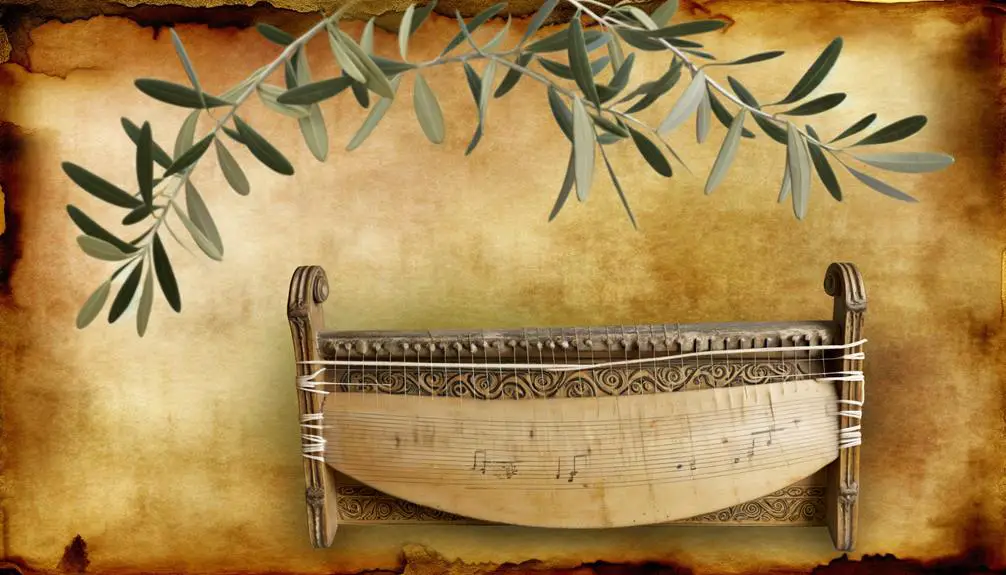
Exploring beyond the psalteries' musical roles in Psalms reveals their deeper symbolic and significant contributions to biblical narratives. These stringed instruments, resonant with the harmonies of worship, also serve as profound musical metaphors within the scriptural context. They encapsulate themes of joy, divine intervention, and spiritual warfare, transcending mere musicality to embody the multifaceted expressions of faith and devotion in the ancient world.
- Joy and Celebration: Psalteries often symbolize the exuberant joy of connecting with the Divine. Their melodious strings aren't just for worship but signify the rejoicing of the soul in its communion with God. This joy isn't superficial; it's a profound expression of spiritual fulfillment and divine blessing.
- Divine Intervention: In several passages, the psalteries' music metaphorically represents God's intervention in human affairs. The sound of these instruments, in context, can symbolize the voice of God breaking into the mundane, offering guidance, comfort, and sometimes, warning. This aspect of psalteries points to their role not just as instruments of praise but as mediums through which the divine communicates with the faithful.
- Spiritual Warfare: The use of psalteries in worship can also be seen as a form of spiritual warfare. Their music, in a symbolic sense, wards off evil and invites the presence of the holy, creating a sanctuary of peace and protection for the believer.
These symbolic dimensions, while enriching, haven't been without their interpretive controversies. Scholars and theologians continue to debate the extents of these metaphors, reflecting the complexities and the rich tapestry of biblical interpretation.
Construction and Design
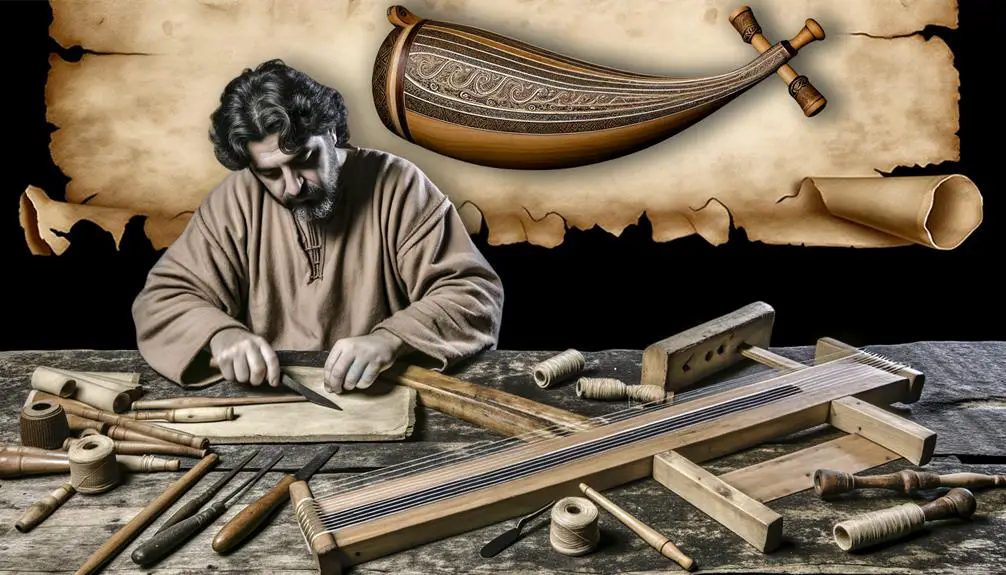
You'll find that the materials used in psalteries' construction vary significantly, reflecting both the geographical availability of resources and the cultural significance attributed to different woods and strings.
The design variations are equally critical in understanding the instrument's evolution, as they mirror changes in musical styles and technological advancements over time.
Analyzing these aspects offers profound insights into the historical and cultural contexts shaping the psalteries described in biblical passages.
Materials Used
In constructing psalteries, craftsmen historically utilized materials such as wood, animal skin, and metal, reflecting the instrument's cultural and functional significance in biblical times. The choice of materials wasn't arbitrary but deeply intertwined with the psaltery's acoustical properties, playing techniques, and even the performer's attire.
- Wood provided the foundational structure, chosen for its resonance and durability. Different types of wood affected the instrument's tone and volume, lending each psaltery a unique sound.
- Animal skin, typically goat or sheep, was stretched over parts of the psaltery to create a resonant surface. This component was crucial for amplifying the vibrations produced by the strings.
- Metal was used for the strings and sometimes for decorative elements. The type of metal influenced the timbre and pitch, allowing craftsmen to customize the psaltery's sound to suit specific musical or ceremonial purposes.
Design Variations
Psalteries exhibited a remarkable array of design variations, each tailored to the specific acoustical and aesthetic demands of its cultural context. You'll find their construction fascinating, as they were crafted to accommodate diverse tuning methods and performance techniques. This adaptability allowed musicians to produce a wide range of sounds, from the deeply resonant to the brilliantly clear.
Feature |
Impact on Design |
Influence on Playability |
|---|---|---|
Shape |
Dictated resonance and volume |
Affected handling and performance techniques |
String Material |
Determined tonal quality |
Influenced tuning methods and sound range |
Tuning Mechanism |
Enabled precision in sound |
Facilitated ease of tuning and maintenance |
Size |
Influenced portability |
Dictated the range of musical expression |
These elements collectively contributed to the psaltery's versatility and enduring presence in musical traditions.
The Role in Worship
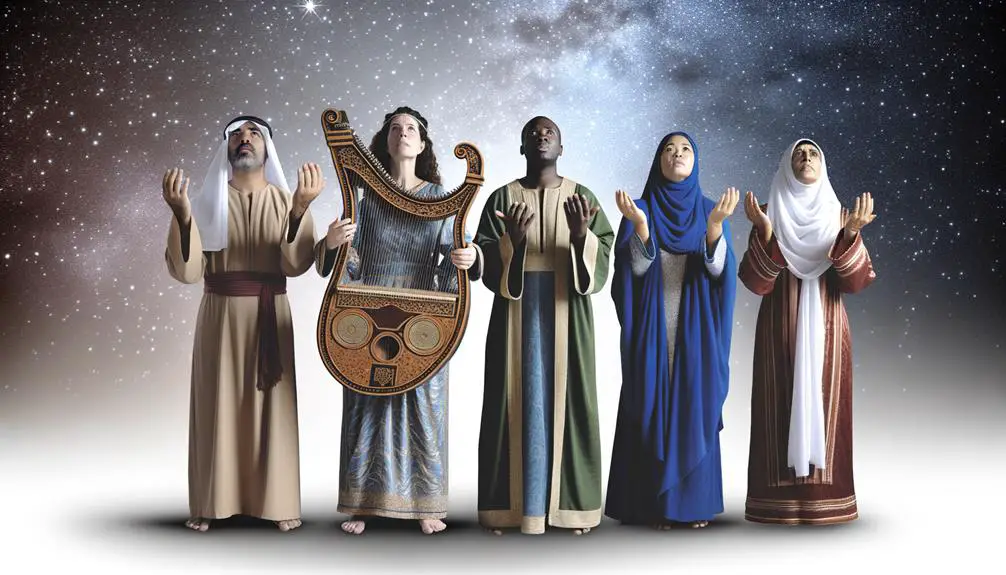
Throughout biblical history, psalteries played a pivotal role in worship, serving as a central instrument in expressing devotion and reverence to God. This stringed instrument, with its melodious and harmonious tones, supported worship practices in ways that were both profound and integral to spiritual life. As you dive deeper into understanding its significance, you'll uncover the nuanced ways in which psalteries enriched worship experiences.
- Psaltery Techniques: Mastery over various playing techniques, such as plucking and strumming, allowed musicians to produce a range of sounds that could evoke a wide spectrum of emotions among the congregation. This versatility made the psaltery a dynamic tool for enhancing worship, enabling musicians to match the tone of their music with the theme of the service, whether it was a solemn occasion or a joyous celebration.
- Worship Practices: The integration of psalteries into worship practices wasn't merely for aesthetic pleasure but served a deeper, spiritual purpose. The instrument's sound was believed to elevate prayers and praises, making them more pleasing to God. This belief underscored the importance of music in worship and the psaltery's role in facilitating a deeper connection between the faithful and the divine.
- Liturgical Significance: The psaltery's use during specific liturgical events underscored its importance in the religious calendar. From festivals to solemn observances, the psaltery's presence added a layer of solemnity and sanctity, reinforcing the spiritual message of the occasion.
In analyzing the role of psalteries in worship, it's evident that their contribution went beyond mere musical accompaniment. They were a vital element in worship practices, enhancing the spiritual ambiance and aiding believers in their expressions of faith.
Variants Across Cultures
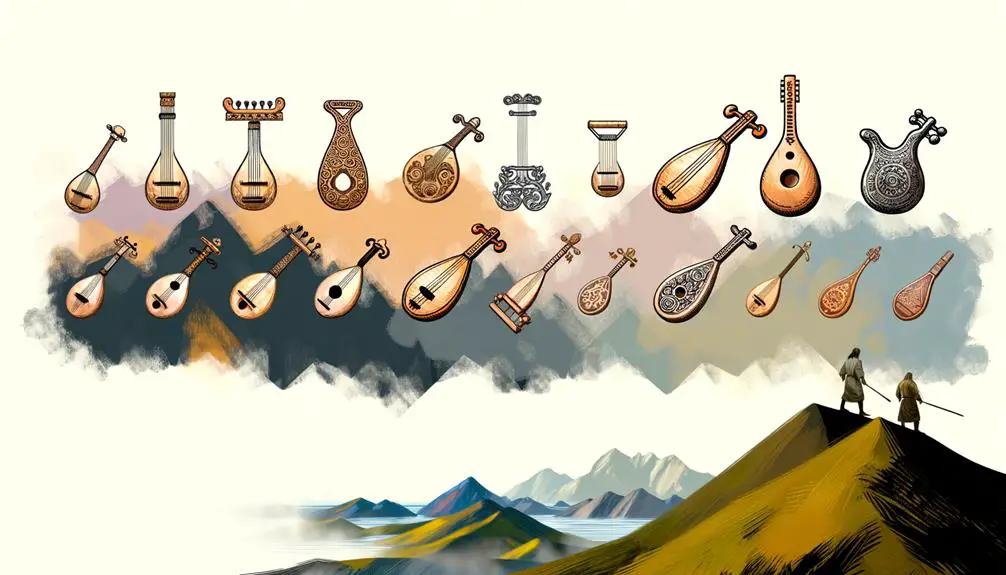
You'll observe that ancient Hebrew psalteries, while foundational, underwent significant transformations upon encountering Greek cultural influences, leading to adaptations in design and usage.
This evolution didn't halt in antiquity; modern interpretations of the psaltery continue to diversify worldwide, reflecting a rich tapestry of cultural exchanges.
Each variant not only tells a story of artistic and musical development but also serves as a mirror reflecting the interplay between tradition and innovation across different societies.
Ancient Hebrew Psalteries
Across various cultures, the ancient Hebrew psalteries exhibited notable variations in design, usage, and significance, reflecting the diverse ways these instruments were integrated into religious and social practices. These variations underscore the adaptability and cultural importance of the psaltery in ancient Hebrew society.
To understand these ancient instruments' complexity, consider the following aspects:
- Tuning techniques: Each region developed unique methods to tune their psalteries, affecting the instrument's sound and the music's emotional impact.
- Performance practices: Varied significantly, from solo performances in religious ceremonies to being part of larger ensembles during festive occasions.
- Material selection: The choice of materials, from local woods to imported strings, influenced the psaltery's timbre and durability, showcasing the interplay between geography and musical innovation.
Greek Psaltery Adaptations
Exploring the Greek adaptations of the psaltery reveals a rich tapestry of cultural exchange and musical evolution, where the instrument's design and usage underwent significant transformations. The Byzantine influence, in particular, played a pivotal role in this musical evolution. It introduced variations in the construction materials, tuning methods, and playing techniques, embedding the psaltery deeply within the fabric of Eastern Orthodox Christian liturgy and secular music.
This period saw the psaltery not just as a mere instrument but as a vessel of cultural identity and expression. Greek artisans experimented with its form, adding more strings and developing new sound-producing mechanisms, thus enriching its tonal qualities. These adaptations reflect a dynamic interplay between tradition and innovation, showcasing a relentless pursuit of musical excellence and cultural resonance.
Modern Interpretations Worldwide
In today's global musical landscape, the psaltery's evolution showcases a remarkable diversity, reflecting its adaptation and integration into various cultural traditions around the world. This instrument's journey from biblical times to the present day illuminates its enduring appeal and versatility. Key developments include:
- Psaltery festivals: Annual gatherings celebrate the instrument's heritage, featuring performances that blend traditional and contemporary styles, illustrating the psaltery's adaptability.
- Digital adaptations: Innovations in technology have led to virtual psalteries, allowing users to experience its sounds and techniques through apps and software, broadening its accessibility.
- Cross-cultural collaborations: Musicians worldwide fuse the psaltery with local instruments, creating unique sounds that honor traditional roots while embracing global influences.
These trends underscore the psaltery's significance as a bridge between past and present, embodying the fusion of history and innovation.
Notable Biblical References
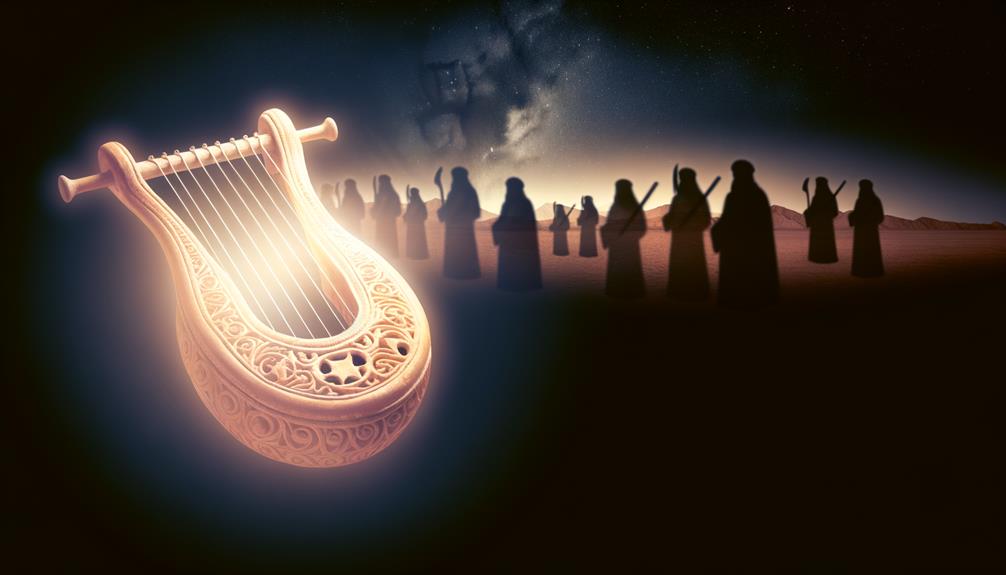
Several passages within the Bible mention psalteries, highlighting their significance in both worship and royal ceremonies. This stringed instrument, akin to a harp, played a pivotal role in the musical traditions of ancient Israel, underscoring the psaltery's importance in connecting the spiritual with the ceremonial.
Delving into the specifics, you'll find that the narrative of psaltery players unfolds as part of a broader musical lineage within the scriptures. For instance, 1 Chronicles 15:16 references the appointment of Levites as musicians, tasked with playing lyres and psalteries to accompany sacred songs, illustrating the institutionalization of music in worship and its orchestration by skilled practitioners. This passage not only underscores the psaltery's role in religious rites but also marks the emergence of a professional class of musicians within the biblical tradition, whose expertise in playing the psaltery was passed down through generations.
Moreover, the mention of psalteries in the context of King Saul's court, as seen in 1 Samuel 10:5, where prophets are described as coming down from a high place with a psaltery, a tabret, and a pipe before them, speaks to the instrument's prestige and its association with prophetic and kingly authority. This reference further amplifies the psaltery's dual function as both a sacred object and a symbol of royal and divine power, bridging the earthly with the divine.
In analyzing these references, it becomes clear that the psaltery was more than just a musical instrument; it was a conduit for worship, a marker of social and religious status, and a testament to the rich musical heritage documented in the Bible.
The Psaltery's Legacy
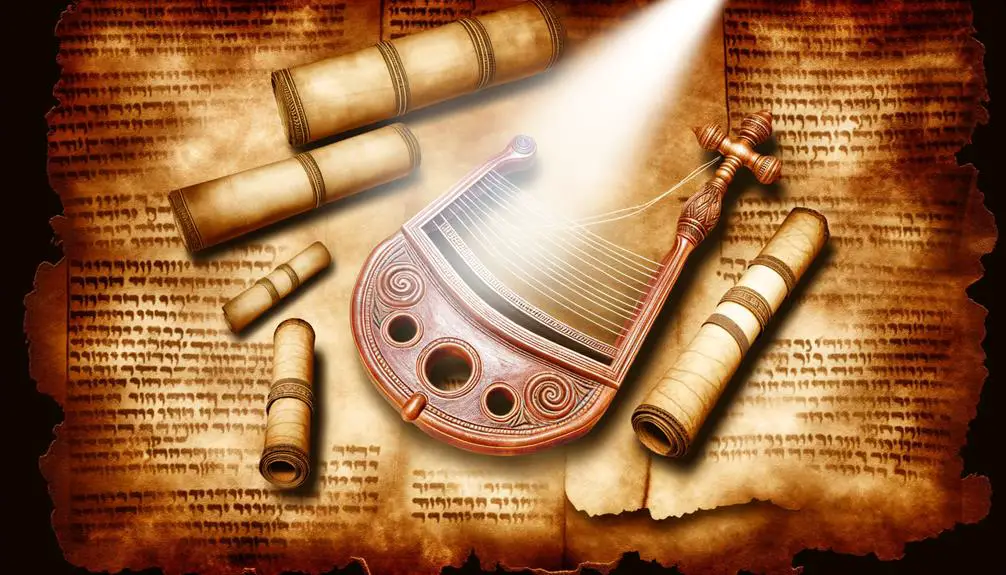
The legacy of the psaltery, deeply entwined with biblical history, reveals its profound impact on both ancient and modern musical traditions. This stringed instrument, once a cornerstone of worship and celebration, continues to resonate through the ages, influencing a diverse range of musical genres and practices. The resurgence of interest in historical musicology and the search for authentic soundscapes have led to significant psaltery revivals, demonstrating the instrument's enduring allure and versatility.
The legacy of the psaltery can be analyzed through three key areas:
- Psaltery Revivals: In recent decades, there's been a notable resurgence in the popularity of the psaltery, driven by a desire to rediscover and reimagine ancient music. This revival isn't merely about historical accuracy; it's also about connecting with a spiritual and musical heritage that predates contemporary conventions.
- Contemporary Performances: Modern musicians and ensembles often incorporate the psaltery into their performances, blending its distinct timbre with both traditional and innovative compositions. This fusion of old and new underscores the psaltery's adaptability and its capacity to add depth and texture to contemporary music.
- Educational Value: The psaltery serves as a tangible link to the past, offering insights into the musical and cultural contexts of biblical times. It has become a focal point in educational settings, where students and enthusiasts alike explore its history, construction, and performance techniques.
Analyzing the psalpy's legacy, it's clear that its historical significance and contemporary relevance are inextricably linked. The instrument's journey from biblical mentions to modern stages exemplifies the timeless nature of music and its power to connect generations.
Frequently Asked Questions
How Do Modern Musicians Incorporate the Psaltery Into Contemporary Christian Music and Worship Practices?
You'll find that modern musicians creatively blend the psaltery into contemporary Christian music through instrument innovation. They're not just sticking to traditional uses; they're experimenting with new sounds and techniques to enrich worship experiences.
Additionally, worship workshops are becoming vital spaces where musicians share and learn how to effectively incorporate the psaltery, ensuring its role is both respected and revitalized. This approach marks a thoughtful fusion of heritage and contemporary worship practices.
Are There Any Specific Psalms or Biblical Passages That Are Considered More Suited or Traditionally Associated With the Psaltery, Outside of Those Directly Mentioning the Instrument?
Imagine you're exploring ancient melodies, and you stumble upon the psaltery's unique sound. There aren't specific psalms or passages outside those mentioning it directly, but think of the instrument's symbolism and construction.
It's about the resonance and harmony it brings to worship. Analyzing its role, you'd find the psaltery elevates any biblical text, not just those traditionally linked to it, by enriching the spiritual ambiance with its melodious strings.
How Has the Perception and Use of the Psaltery Evolved in Non-Christian Religious Traditions and Cultures?
You're exploring how the psaltery's perception and use have evolved in non-Christian traditions and cultures. This journey reveals fascinating cultural adaptations, underscoring the instrument's historical significance.
Analyzing these changes, you'll notice the psaltery's role not just as a musical instrument but as a cultural bridge, reflecting and influencing the traditions it encounters.
This evolution highlights the psaltery's adaptability and enduring appeal across diverse religious and cultural landscapes.
What Are the Challenges and Techniques Involved in Learning to Play the Psaltery for Someone With No Prior Experience With Stringed Instruments?
Learning to play the psaltery as a novice to stringed instruments presents unique challenges. You'll need to master string materials, which affect sound and playability.
Finger positioning is crucial; incorrect placement can hinder your ability to create harmonious sounds. It's a meticulous process requiring patience and precision.
Analyzing the relationship between finger placement and string vibration will guide you in producing the desired musical tones, elevating your playing technique.
Can the Psaltery Be Effectively Used in Solo Performances, or Is It Primarily an Accompaniment Instrument in Ensemble Settings Within Modern Musical Contexts?
You'll find that the psaltery, despite its historical contexts, shines in solo performances thanks to its unique sound and range.
Solo techniques allow for expressive, intricate pieces that highlight the instrument's versatility. While it's commonly seen in ensemble settings, don't underestimate its solo potential.
Mastering these techniques not only showcases your skill but also breathes new life into modern musical contexts, proving the psaltery's standalone capabilities.
Conclusion
In conclusion, you've journeyed through the psaltery's biblical odyssey, from its divine origins to its enduring legacy.
You've seen its symbolic richness, marveled at its intricate design, and understood its pivotal role in worship. Across cultures, its variants sing a testament to its universal appeal.
Its biblical references aren't just footnotes; they're the heartbeat of ancient worship. The psaltery's legacy is nothing short of celestial, echoing through eternity as the instrument that played the soundtrack of the heavens.



Sign up